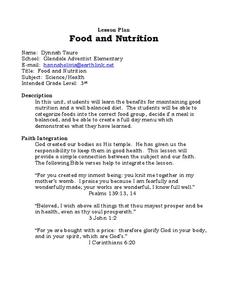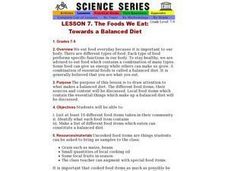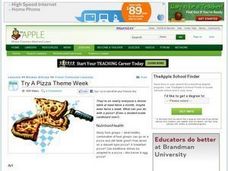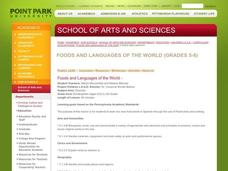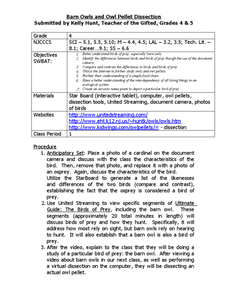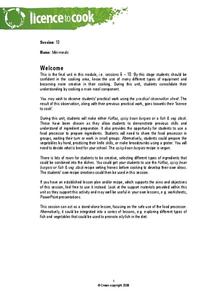Curated OER
Food and Nutrition
Third graders discuss the benefits for maintaining good nutrition and a well balanced diet. They categorize foods into the correct food group, decide if a meal is balanced, and create a full day menu which demonstrates what they have...
Curated OER
Insect Food Chain & Camouflage
Students use art work to demonstrate their understanding of the insect food chain and their ability to camouflage themselves. In this insect food chain and camouflage lesson, students determine what type of animals feed on insects. They...
Curated OER
Go With the Energy Flow
Students explore energy and nutrient flow. In this science instructional activity, students diagram the flow of energy through food chains and food webs. Students discuss the importance of energy flow in Earth's ecosystems.
Curated OER
A Simple Model for Natural Selection
Do you have what it takes to survive as a fit predator or will elusive prey lead to your extinction? Find out in a creative natural selection activity. Using different colors and shapes of grains to represent different species and...
Curated OER
The Foods We Eat: Towards a Balanced Diet
Students list at least 10 different food items grown/produced in their community, identify what each food item contains and make a list of different food items which constitute a balanced diet. They bring in food samples and write food...
Curated OER
Oceanography: Understanding the Relationship Among Ocean Food Chains
Fourth graders explore relationships among organisms involved in ocean food chains to investigate interdependence of the organisms.
Curated OER
Investigating the Food Pyramid
Students examine how the food pyramid is an important nutritional tool. They classify foods and compare the number of servings per group that are necessary for maintaining good health by placing empty food containers in grocery bags.
Curated OER
Simple Machines
Students research simple machines. In this simple machines lesson, students explore the many types of simple machines such as the lever, pulley, and screw. Students discover simple machines in the classroom.
Curated OER
Arctic Food Web
Students research animals found in the arctic. They discuss what living things need in order to survive and where they get their food. Students discuss the difference between producers and consumers and create a food web for animals in...
Curated OER
Food Chain/Food Web
Students explore ecosystems. For this ecology lesson, students read an article explaining ecosystems. Students create a visual organizer with index cards using components of various ecosystems.
Curated OER
Everybody Needs a Little Sunshine
Three activities introduce upper elementary ecologists to photosynthesis and food webs. In the first, an experiment is set up to determine how plants respond to different types of light. In the second, they connect organism cards with...
Curated OER
Try A Pizza Theme Week
Students explore all the things they could do with a pizza. They become aware of food groups and nutritional needs, make decorated cardboard pizzas, interact with pizza slices and fractions, create stories to go along with their...
Curated OER
Links in the Chain of Life
Using the prairie dog community as an example, middle school ecologists examine the food web. Pairs of learners take one species in the community and research its role in the ecosystem. They share their findings with the rest of the...
Curated OER
Levers and Wedges in the Human Body
Young biologists identify parts of the body that serve as wedges (teeth and fingernails), and as levers (jaw, arms, and legs). The hands-on activities described here should be exciting for learners to perform, and should also lead to a...
Curated OER
Dissecting Owl Pellets
Students examine owl pellets and what their diet consisted of, specifically rodents. This furthers their understanding of simple food chains as well as bone structure and identification.
Curated OER
Recyclers to the Rescue
Producers, consumers, food chains, and plants are the stars of this science lesson. Learners take part in an inquiry which helps them to discover the most effective and efficient way to grow a producer. They have a variety of containers...
National Park Service
Reduce Our Carbon Footprint, Let’s Compost!
Roll up your sleeves and get a little dirty with this elementary and middle school compost lesson plan. All you need is a large plastic container, a couple old newspapers, some organic waste, and a few hundred worms and you're ready...
Curated OER
Foods and Languages of the World
Young scholars review Mexico's location and language and learn to pronouns 10 new Spanish food words. Students listen as the book, Corn is Maize is read, touching and passing around an ear of Indian corn. Young scholars discuss the...
Curated OER
Toting the Log and Lifting the Babe
Students use simple machines that demonstrate force, friction, work and power. They investigate and explain simple machines.
Curated OER
Owl Pellets
Sixth graders investigate the role of owls in their ecosystem. In this food chain lesson, 6th graders illustrate an owl food chain, dissect an owl pellet, and analyze data. Students discuss what would happen to owls if there were an...
Curated OER
Packaging and Transport
Students examine the methods by which food is packaged and transported to their dinner tables. In this packaging and transporting lesson plan, students explore how machines help people grow food. Students also obtain knowledge about how...
Curated OER
Barn Owls and Owl Pellet Dissection
Students explore birds of prey and food chains. For this ecosystems and birds of prey cross curriculum science and literacy lesson, students brainstorm characteristics of birds after viewing photographs. Students view a video and...
Curated OER
Mini Meals
Learners discuss what makes a healthy and balanced meal, and then they make them out of clay. They use hand building techniques, radial design, and their knowledge of healthy foods to create unique mini-sized meals for a wall display.
Desert Museum
Daisy Ecology
Here's a fine lesson that combines poetry with life sciences. Learners carefully listen to a poem that's all about a food chain. As the poem is read, learners name the producer, the herbivore, the carnivore, and the omnivore. Lots of...
